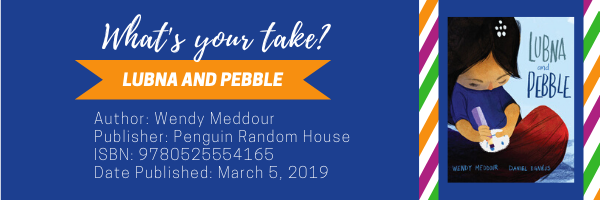By Susan Corapi, Trinity International University, Deerfield, IL, and Deanna Day, Washington State University, Vancouver, WA
This month Susan Corapi and Deanna Day selected titles that were submitted to the Outstanding International Book committee. The OIB committee reads approximately 500 books and selects 42 distinguished titles that represent the best global books in the world. The committee announced the winning titles at the American Library Association conference in January. Visit the United States Board on Books for Young People(USBBY) website for the complete 2020 list of books where you can download a bookmark and a PowerPoint presentation.
As part of the work of the committee themes and issues were identified across all of the titles and for this column we selected books that address crossing borders, whether literally or figuratively.
DEANNA: Many young children have a blankie or stuffed animal that comforts them, but in this beautiful picturebook Lubna has a pebble. She finds it on the beach when she and her father arrive in the night at a refugee camp. The opening double page spread shows a close up view of Lubna’s face with inquisitive eyes, “Lubna’s best friend was a pebble. It was shiny and smooth and gray.”
Lubna falls asleep in her Daddy’s salty arms and continues holding onto her pebble. Daniel Egnéus, the illustrator, portrays the father as huge, tall and comforting with broad shoulders and muscular arms. Egnéus has purposely created interesting perspectives, where the reader’s eyes are at the level of a child and must look up at the giant hand holding the small palm or large outstretched arms asking for a hug. There is no doubt that Lubna feels safe and secure with her Daddy.
As this enchanting story progresses, Lubna meets a new friend, a fellow refugee named Amir. Lubna befriends him and introduces pebble to him. They play hide and seek together and keep each other company while their families wait in the “World of Tents.” Eventually, Lubna’s family finds a new home and Lubna has mixed feelings about leaving Amir. Before her family moves on Lubna passes on the gift that has helped her through hard times. Hopefully Amir will find the same fortune with pebble.
The book closes with a double page spread similar to the opening with Amir’s large face and eyes, staring at pebble. The text reads, “Hello, Pebble.” This simple picturebook conveys deep emotions and is a perfect entryway to discussing refugees with very young children.
What did you think Susan?
SUSAN: I have read a lot of children’s books that deal with the refugee experience, and there is something unique about this one. The focus of the story is not on the trauma of having to suddenly leave your home or lose your mother, though those themes are present in the narrative. Instead the focus is on friendship, care and safety. The close-ups hone in on sheltering arms, a comfortable cozy “bed” for Pebble. The overall effect is the safe care Lubna gives Pebble.
This story prompts so many thoughts! What is the role of imaginary friends in calming us down? What makes me personally feel safe and cared for? What have I read about other objects that help kids through tough times? How do we care for ourselves in times of great stress?
So, let me follow one train of thought–that of taking some sort of action to reduce stress. At present the faculty in my Division of Education is reading a book about mindfulness. The chapter we discussed today is on positivity and actions we can take to “talk ourselves off the ledge” instead of spiraling down into negativity. The story of Lubna is a great example of a little girl taking some sort of action to change her circumstances to the degree she could. At the risk of sounding like a Pollyanna, a small girl took a small action and cared for a small pebble–all with a big impact on both her emotions and those of fellow refugee Amir.
What was the part of the story that sat in your soul for days afterward?
DEANNA: The illustrations. Daniel Egnéus’ artwork is breathtaking–one can’t help but see how special pebble is to these two children. Both Amir’s and Lubna’s eyes, facial expressions and careful touch, display so much.
Another title that we received for OIB was Idriss and his Marble by René Gouichoux with illustrations by Zaü (StarBerry Books, 2019). Just like Lubna, Idriss has one marble to keep him company as his mother and he flee danger and travel to safety. Idriss’ small marble helps him dream and imagine a better life. It is interesting the both of these picturebooks depict how a small object can bring such happiness to young children. Furthermore, both objects help the children take action like you mention Susan and even help them make friends. Pairing both of these titles together could be really interesting.
SUSAN: I agree! They both address the role of comfort objects in the middle of stressful times, particularly that of being a refugee. And both have stunning illustrations that use double-page spreads to communicate strong emotions.
I have pored over the pictures again in Lubna and the Pebble after reading your comment. I am not trained in art, so what I know has come from working hard to understand the art of illustration. I am trying to describe what I see and how that makes me feel as a reader because the art points us toward that theme of safety and care.
The zooming in and double-page spreads lets the reader focus on details like the emotion in the eyes. You mention Lubna’s big eyes at the beginning of the story and how they are echoed in Amir’s big eyes at the end of the story. The reader is positioned as the pebble, and our eyes are locked in a relationship with Lubna and Amir. What I notice too is the primitive quality of the art, which helps us focus on the emotional aspect of the story. We are not distracted with details. We clearly notice Lubna’s father’s large arms that shelter. We see Lubna sheltering Pebble. And the cool palette of blues calms us down and makes us feel settled.
The words help too–ones like best friend, clutched, gripped, safe, happy face, always, come close. Overall this book makes me feel safe in the middle of intense drama.
Title: Lubna and Pebble
Author: Wendy Meddour
Illustrator: Daniel Egnéus
ISBN: 9780525554165
Publisher: Dial Books for Young Readers (Penguin)
PubDate: March 5, 2019
Throughout February 2020, Susan and Deanna give their take on books focused on narratives that cross borders. Check back each Wednesday to follow the conversation!
- Themes: Deanna Day-Wiff, Lubna and Pebble, Susan Corapi, Wendy Meddour
- Descriptors: Books & Resources, My Take/Your Take


